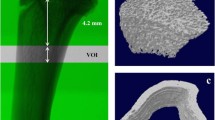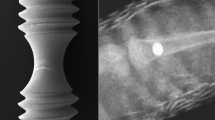Abstract
Summary
Mechanical loading at high frequency affects bone. Whether this also applies to osteoporotic bone, combined or not with bisphosphonate therapy, was investigated in this animal study through imaging. An anabolic effect of high-frequency loading on osteoporotic bone, however non-synergistic with bisphosphonates, was found, thereby revealing its potential for treatment of osteoporosis.
Introduction
In an effort to elucidate the effect of high-frequency (HF) loading on bone and to optimize its potential for treatment osteoporosis, this study aimed to investigate the effect of HF loading via whole body vibration (WBV), alone or in association with bisphosphonate treatment (alendronate—ALN), on the micro-architecture of ovariectomy (OVX)-induced compromised bone.
Methods
Eighty-four female Wistar rats were ovariectomized (OVX) or sham-operated (shOVX). OVX animals were treated either with ALN (3 days/week at a dose of 2 mg/kg) or with saline solution. Each group (shOVX, OVX, ALN) was further divided into subgroups relative to the loading status (sham-WBV versus WBV) and the duration of experimental period (4 days versus 14 days). (Sham)WBV loading was applied for 10 min/day using 10 consecutive steps of HF loading (130, 135, 140, 145, 150, 130, 135, 140, 145, 150 Hz). Tibial bone structural responses to WBV and/or ALN treatment were analyzed using ex vivo micro-computed tomography.
Results
The animal’s hormonal status displayed a major impact on the trabecular and cortical bone structural parameters. Furthermore, mechanical treatment with HF WBV increased the cortical thickness and reduced the medullar area in OVX rats. However, OVX trabecular bone was not affected by HF stimuli. Finally, ALN prevented OVX-associated bone loss, but the association of ALN with WBV did not lead to a synergistic bone response in OVX bone.
Conclusions
HF WBV mechanical stimulation displayed an anabolic effect on osteoporotic cortical bone, confirming its therapeutic properties for enhancing compromised bone. Additionally, its association with bisphosphonates’ administration did not produce any additive effect on the bone micro-architecture in the present study.




Similar content being viewed by others
References
Rachner TD, Khosla S, Hofbauer LC (2011) Osteoporosis: now and the future. Lancet 377:1276–1287. doi:10.1016/S0140-6736(10)62349-5
Melton LJ III, Chrischilles EA, Cooper C et al (2005) How many women have osteoporosis? J Bone Miner Res 7:1005–1010
Burge R, Dawson-Hughes B, Solomon DH et al (2007) Incidence and economic burden of osteoporosis-related fractures in the United States, 2005-2025. J Bone Miner Res Off J Am Soc Bone Miner Res 22:465–475
Inada M, Miyaura C (2010) Cytokines in bone diseases. Cytokine and postmenopausal osteoporosis. Clin Calcium 20:1467–1472
Pacifici R (1996) Estrogen, cytokines, and pathogenesis of postmenopausal osteoporosis. J Bone Miner Res Off J Am Soc Bone Miner Res 11:1043–1051
Sambrook P, Cooper C (2006) Osteoporosis. Lancet 367:2010–2018
Siris ES, Selby PL, Saag KG et al (2009) Impact of osteoporosis treatment adherence on fracture rates in North America and Europe. Am J Med 122:S3–S13
E O, Luu Y, B A, et al. (2010) Mechanical signals as anabolic agents in bone. Nature 6:50–59
Judex S, Rubin CT (2010) Is bone formation induced by high-frequency mechanical signals modulated by muscle activity? J Musculoskelet neuronal Interact 10:3–11
Judex S, Lei X, Han D, Rubin C (2007) Low-magnitude mechanical signals that stimulate bone formation in the ovariectomized rat are dependent on the applied frequency but not on the strain magnitude. J Biomech 40:1333–1339
Oxlund B, Ørtoft G, Andreassen T, Oxlund H (2003) Low-intensity, high-frequency vibration appears to prevent the decrease in strength of the femur and tibia associated with ovariectomy of adult rats. Bone 32:69–77. doi:10.1016/S8756-3282(02)00916-X
Chen B, Li Y, Yang X, Xie D (2013) Comparable effects of alendronate and strontium ranelate on femur in ovariectomized rats. Calcif Tissue Int 93:481–486
Chen B, Li Y, Xie D, Yang X (2012) Low-magnitude high-frequency loading via whole body vibration enhances bone-implant osseointegration in ovariectomized rats. J Orthop Res 30:733–739. doi:10.1002/jor.22004
Ogawa T, Possemiers T, Zhang X et al (2011) Influence of whole-body vibration time on peri-implant bone healing: a histomorphometrical animal study. J Clin Periodontol 38:180–185. doi:10.1111/j.1600-051X.2010.01637.x
Ogawa T, Zhang X, Naert I et al (2011) The effect of whole-body vibration on peri-implant bone healing in rats. Clin Oral Implants Res 22:302–307. doi:10.1111/j.1600-0501.2010.02020.x
Tezval M, Biblis M, Sehmisch S et al (2011) Improvement of femoral bone quality after low-magnitude, high-frequency mechanical stimulation in the ovariectomized rat as an osteopenia model. Calcif Tissue Int 88:33–40
Brouwers JEM, Van Rietbergen B, Ito K, Huiskes R (2010) Effects of vibration treatment on tibial bone of ovariectomized rats analyzed by in vivo micro-CT. J Orthop Res 28:62–69
Sehmisch S, Galal R, Kolios L, et al. (2009) Effects of low-magnitude, high-frequency mechanical stimulation in the rat osteopenia model. Osteoporos Int a J Establ as result Coop between Eur Found Osteoporos Natl Osteoporos Found USA 20:1999–2008
Rubinacci A, Marenzana M, Cavani F et al (2008) Ovariectomy sensitizes rat cortical bone to whole-body vibration. Calcif Tissue Int 82:316–326
Bouxsein ML, Boyd SK, Christiansen BA et al (2010) Guidelines for assessment of bone microstructure in rodents using micro-computed tomography. J Bone Miner Res Off J Am Soc Bone Miner Res 25:1468–1486
Adams JE (2013) Advances in bone imaging for osteoporosis. Nat Rev Endocrinol 9:28–42. doi:10.1038/nrendo.2012.217
Khosla S, Oursler MJ, Monroe DG (2012) Estrogen and the skeleton. Trends Endocrinol Metab TEM 23:576–581. doi:10.1016/j.tem.2012.03.008
Ishihara A, Sasaki T, Debari K et al (1999) Effects of ovariectomy on bone morphology in maxillae of mature rats. J Electron Microsc (Tokyo) 48:465–469
Shi H-F, Cheung W-H, Qin L et al (2010) Low-magnitude high-frequency vibration treatment augments fracture healing in ovariectomy-induced osteoporotic bone. Bone 46:1299–1305. doi:10.1016/j.bone.2009.11.028
Van Der Jagt OP, Van Der Linden JC, Waarsing JH et al (2012) Low-magnitude whole body vibration does not affect bone mass but does affect weight in ovariectomized rats. J Bone Miner Metab 30:40–46. doi:10.1007/s00774-011-0293-5
Burghardt AJ, Kazakia GJ, Sode M et al (2010) A longitudinal HR-pQCT study of alendronate treatment in postmenopausal women with low bone density: relations among density, cortical and trabecular microarchitecture, biomechanics, and bone turnover. J Bone Miner Res Off J Am Soc Bone Miner Res 25:2558–2571. doi:10.1002/jbmr.157
Eastell R, Walsh JS, Watts NB, Siris E (2011) Bisphosphonates for postmenopausal osteoporosis. Bone 49:82–88. doi:10.1016/j.bone.2011.02.011
Rogers MJ, Crockett JC, Coxon FP, Mönkkönen J (2011) Biochemical and molecular mechanisms of action of bisphosphonates. Bone 49:34–41
Roschger P, Rinnerthaler S, Yates J et al (2001) Alendronate increases degree and uniformity of mineralization in cancellous bone and decreases the porosity in cortical bone of osteoporotic women. Bone 29:185–191
Feher A, Koivunemi A, Koivunemi M et al (2010) Bisphosphonates do not inhibit periosteal bone formation in estrogen deficient animals and allow enhanced bone modeling in response to mechanical loading. Bone 46:203–207
Lee K, Jessop H, Suswillo R, et al. (2003) Endocrinology: bone adaptation requires oestrogen receptor-alpha. Nature 24;389
Lee KCL, Lanyon LE (2004) Mechanical loading influences bone mass through estrogen receptor [alpha]. Exerc Sport Sci Rev 32:64–68
Lim SK, Won YJ, Lee HC et al (1999) A PCR analysis of ERalpha and ERbeta mRNA abundance in rats and the effect of ovariectomy. J Bone Miner Res Off J Am Soc Bone Miner Res 14:1189–1196
Hoyland J (1999) Effect of ovarian steroid deficiency on oestrogen receptor alpha expression in bone. J Pathol 188:294–303
Seeman E (2007) The periosteum—a surface for all seasons. Osteoporos Int 18:123–128
Saxon L, Turner C (2005) Estrogen receptor beta: the antimechanostat? Bone 36:185–192
Saxon LK, Robling AG, Castillo AB et al (2007) The skeletal responsiveness to mechanical loading is enhanced in mice with a null mutation in estrogen receptor. Am J Physiol Endocrinol Metab 293:E484–E491. doi:10.1152/ajpendo.00189.2007
Saxon LK, Turner CH (2006) Low-dose estrogen treatment suppresses periosteal bone formation in response to mechanical loading. Bone 39:1261–1267
Iwamoto J, Takeda T, Sato Y, Uzawa M (2005) Effect of whole-body vibration exercise on lumbar bone mineral density, bone turnover, and chronic back pain in post-menopausal osteoporotic women treated with alendronate. Aging Clin Exp Res 17:157–163
Iwamoto J, Sato Y, Takeda T, Matsumoto H (2012) Whole body vibration exercise improves body balance and walking velocity in postmenopausal osteoporotic women treated with alendronate: Galileo and Alendronate Intervention Trail (GAIT). J Musculoskelet Neuronal Interact 12:136–143
Lespessailles E, Jaffré C, Beaupied H et al (2009) Does exercise modify the effects of zoledronic acid on bone mass, microarchitecture, biomechanics, and turnover in ovariectomized rats? Calcif Tissue Int 85:146–157
Fuchs R, Shea M, Durski S et al (2007) Individual and combined effects of exercise and alendronate on bone mass and strength in ovariectomized rats. Bone 41:290–296
Waarsing JH, Day JS, Van Der Linden JC et al (2004) Detecting and tracking local changes in the tibiae of individual rats: a novel method to analyse longitudinal in vivo micro-CT data. Bone 34:163–169
Boyd SK, Davison P, M??ller R, Gasser JA (2006) Monitoring individual morphological changes over time in ovariectomized rats by in vivo micro-computed tomography. Bone 39:854–862
Pei L, Tontonoz P (2004) Fat’s loss is bone’s gain. J Clin Invest 113:805–806
Acknowledgments
The author would like to acknowledge Dr. A. Ivanova for the help with the statistical analysis. This work was supported by the Fund for Scientific Research Flanders (FWO Flanders—postdoctoral researcher K. Vandamme) and by the Brazilian Science Without Borders Program (246131/2012-8 process, Phd student G.V. Camargos; 245450/2012-2 process, Postdoctoral researcher F. Faot).
Conflicts of interest
The authors Kouki Hatori, Germana De Villa Camargos, Marissa Chatterjee, Fernanda Faot, Keiichi Sasaki, Joke Duyck, and Katleen Vandamme declare that there are no conflicts of interest related to the manuscript.
Author information
Authors and Affiliations
Corresponding author
Electronic supplementary material
Below is the link to the electronic supplementary material.
ESM 1
(DOCX 4726 kb)
Rights and permissions
About this article
Cite this article
Hatori, K., Camargos, G.V., Chatterjee, M. et al. Single and combined effect of high-frequency loading and bisphosphonate treatment on the bone micro-architecture of ovariectomized rats. Osteoporos Int 26, 303–313 (2015). https://doi.org/10.1007/s00198-014-2857-4
Received:
Accepted:
Published:
Issue Date:
DOI: https://doi.org/10.1007/s00198-014-2857-4




